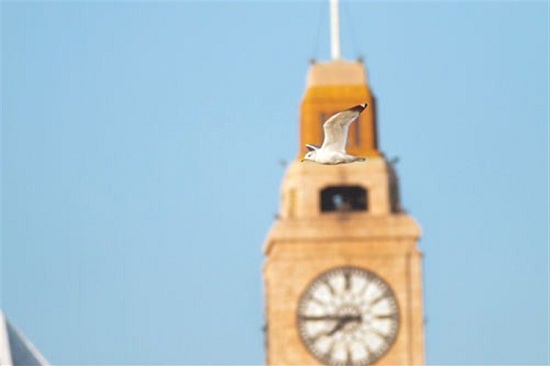On the Bund, seeing the seagulls’ allure
 0 Comment(s)
0 Comment(s) Print
Print E-mail Shanghai Daily, February 25, 2016
E-mail Shanghai Daily, February 25, 2016

In a fierce battle for food, I recently watched four seagulls fight for a long, fatty eel as they flew over the Huangpu River. Standing on the riverfront in Lujiazui as I stared at the determined birds, I thought about how much they are part of the Bund and its surroundings. And yet it's the iconic skyline that tourists and locals marvel at, instead of the flocks of gulls that hover over the water.
To most they are a nuisance.
In the West, seagulls are among the most disliked birds, and are often referred to as rats of the sky, or flying rats, for their threatening behavior and tendency to scavenge and steal food. In some cities, they have started to live entirely off garbage and frequently steal food straight from people's hands. Their aggressive search for anything edible has drawn the scorn of locals who have gone as far as to poison and kill the birds.
In a 2014 study in the UK, 95 percent of respondents even said that they "detest" seagulls. But to me, the gulls that populate the Huangpu and Bund area between November and March are interesting birds to observe.
From 7 to 10am, a dozen species of herring gulls, also called Vega gulls, Mongolian gulls and Heuglin's gulls are actively searching for food, constantly flying above the water to scan the river for prey.
When one gull spots a fish, it will dive in to catch it. In that moment, the other gulls seem to turn around instinctively and will soon swarm the successful hunter to steal the fresh prey.
Sometimes a gull rips a fish from another gull's bill, only to loose it to yet another competitor seconds later.
It's fascinating to watch.
Few people know what a long way these birds have come to fish in the Huangpu River. Every year, the gulls leave their breeding grounds in Siberia and Mongolia in search for warmer waters. They arrive here in mid-November and stay until March, when the weather allows for their return north.
Like other birds, the gulls migrate in fixed routes, with the juveniles following the adults in fall to learn the route to their wintering grounds. Most of them are found in the Bund area, Paotaiwan Wetland, Chongming Island, Nanhui Dongtan as well as Dianshan Lake.
Shanghai has been the herring gulls' winter palace for hundreds of years due to its good habitat conditions and rich food source. Although they prefer fish and shrimp or other seafood, they will also eat small rodents and smaller birds.
The mud banks at the Bund, where the Suzhou Creek enters the Huangpu River, are a habitat for certain fish species, which has attracted the gulls.
As some gulls can live up to several decades, I can't help but think about how they have witnessed Shanghai's rapid transformation, with ever taller buildings welcoming them each season.
Gulls were already here when the first fishermen arrived, and quickly learned that ships will leave small fish and shrimps behind — a welcome and easy snack for the birds.
Apart from the abundance of food, the Bund area is also a safe haven for the birds. They've long been used to passing boats and ships, and there are almost no other distractions.
The best spot to observe the gulls on the Bund is by the riverfront in Lujiazui, conveniently located near the Lujiazui station of Metro Line 2. Most gulls gather in the northern area closer to the estuary.
About the gulls
Mongolian gull 蒙古銀鷗
Scientific name: Larus mongolicus
The Mongolian gull is about 55 to 68 centimeters in length with a wingspan of 140 to 155 centimeters, weights approximately 1.125 kilograms. It has long neck that is thick at the base and pointed at the head when stretched, but appears full-chested when relaxed.
The adult Mongolian gull has a round head that's typically white with any winter streaking usually faint and restricted to the lower hindneck. The juvenile has dark brown upperparts with pale-fringed feathers giving it a scaled appearance. The head is almost white with contrasting black bill and brown-streaked neck and breast.
As a migratory species, the Mongolian gull breeds east of Mongolia's Lake Baikal, in northeast China and Korea. They winter mainly around the Yellow Sea, Korea and on China's southeastern coast.
Black-headed gull 紅嘴鷗
Scientific name: Chroicocephalus ridibundus
The black-headed gull is a relatively smaller gull with 37 to 43 centimeters in length and a wingspan of 94 to 110 centimeters. It weighs 195 to 325 grams. It's grey and white, with a pale grey mantle and wings, a dark, chocolate-brown hood and distinctive white leading edge, with only a small black spot on the tip of the wings.
This species breeds in western Europe to northeastern Yakutsk, southeastern Russia, Sakhalin, Kamchatka, Koryakia and the northeast of China. It winters in Japan, Korea, Taiwan and the coast of east China, usually south of the Yangtze River estuary.
Common gull 海鷗
Scientific name: Larus canus
The common gull is about 40 to 46 centimeters in length with a wingspan of 110 to 125cm. It weighs about 394 to 586 grams.
The medium-sized gull has a rounded head, plain face and rather gentle appearance. The adult Common gull's breeding plumage has grey wings, a prominent white tertial crescent that separates the grey of the wings from the black primaries. The head, neck, underparts and tail are white. But in winter, the ear coverts, nape and neck-sides are narrowly streaked or more broadly flecked brown, and the head streaking can be heavy.
The Common gull breeds across Eurasia and northwest North America and in eastern Russia, from Sakhalin to Yakutia and Chukotka to Kamchatka as well as northern China. It winters from October to April in Japan, Korea, the East China coast and occasionally Taiwan.
Black-tailed gull 黑尾鷗
Scientific name: Larus crassirostris
The black-tailed gull is 44 to 48 centimeters long with a wingspan of 126 to 128 centimeters. It weighs 436 to 640 grams. It's a medium-sized, long, narrow-winged gull with a broad black tail-band. The white head appears relatively flat-crowned and is further accentuated by a long bill.
It is found in the east Asia, from north Sakhalin to the Japanese coast and offshore islands, offshore Korea, Shandong and Fujian provinces in China as well as Taiwan. It winters in areas ranging from Hokkaido in northern Japan to Taiwan and south China.






